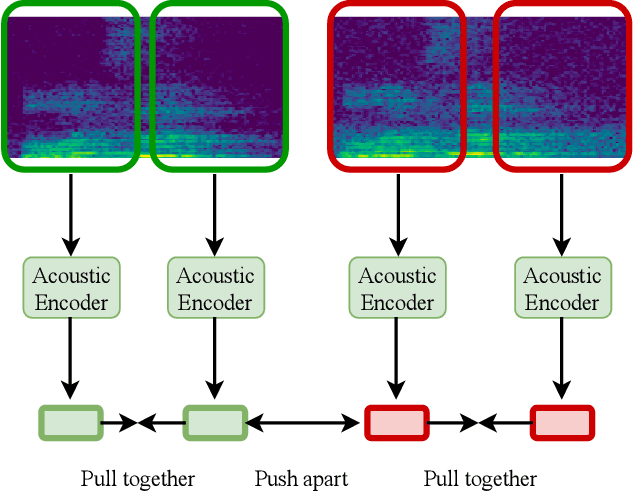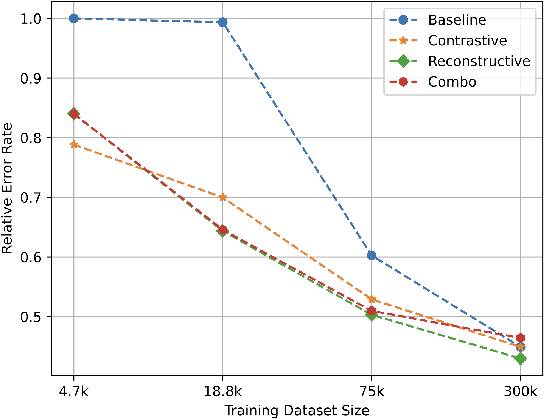John Harvill
LI-TTA: Language Informed Test-Time Adaptation for Automatic Speech Recognition
Aug 11, 2024Abstract:Test-Time Adaptation (TTA) has emerged as a crucial solution to the domain shift challenge, wherein the target environment diverges from the original training environment. A prime exemplification is TTA for Automatic Speech Recognition (ASR), which enhances model performance by leveraging output prediction entropy minimization as a self-supervision signal. However, a key limitation of this self-supervision lies in its primary focus on acoustic features, with minimal attention to the linguistic properties of the input. To address this gap, we propose Language Informed Test-Time Adaptation (LI-TTA), which incorporates linguistic insights during TTA for ASR. LI-TTA integrates corrections from an external language model to merge linguistic with acoustic information by minimizing the CTC loss from the correction alongside the standard TTA loss. With extensive experiments, we show that LI-TTA effectively improves the performance of TTA for ASR in various distribution shift situations.
Mitigating the Exposure Bias in Sentence-Level Grapheme-to-Phoneme (G2P) Transduction
Aug 16, 2023



Abstract:Text-to-Text Transfer Transformer (T5) has recently been considered for the Grapheme-to-Phoneme (G2P) transduction. As a follow-up, a tokenizer-free byte-level model based on T5 referred to as ByT5, recently gave promising results on word-level G2P conversion by representing each input character with its corresponding UTF-8 encoding. Although it is generally understood that sentence-level or paragraph-level G2P can improve usability in real-world applications as it is better suited to perform on heteronyms and linking sounds between words, we find that using ByT5 for these scenarios is nontrivial. Since ByT5 operates on the character level, it requires longer decoding steps, which deteriorates the performance due to the exposure bias commonly observed in auto-regressive generation models. This paper shows that the performance of sentence-level and paragraph-level G2P can be improved by mitigating such exposure bias using our proposed loss-based sampling method.
INTapt: Information-Theoretic Adversarial Prompt Tuning for Enhanced Non-Native Speech Recognition
May 25, 2023



Abstract:Automatic Speech Recognition (ASR) systems have attained unprecedented performance with large speech models pre-trained based on self-supervised speech representation learning. However, these pre-trained speech models suffer from representational bias as they tend to better represent those prominent accents (i.e., native (L1) English accent) in the pre-training speech corpus than less represented accents, resulting in a deteriorated performance for non-native (L2) English accents. Although there have been some approaches to mitigate this issue, all of these methods require updating the pre-trained model weights. In this paper, we propose Information Theoretic Adversarial Prompt Tuning (INTapt), which introduces prompts concatenated to the original input that can re-modulate the attention of the pre-trained model such that the corresponding input resembles a native (L1) English speech without updating the backbone weights. INTapt is trained simultaneously in the following two manners: (1) adversarial training to reduce accent feature dependence between the original input and the prompt-concatenated input and (2) training to minimize CTC loss for improving ASR performance to a prompt-concatenated input. Experimental results show that INTapt improves the performance of L2 English and increases feature similarity between L2 and L1 accents.
SPADE: Self-supervised Pretraining for Acoustic DisEntanglement
Feb 03, 2023



Abstract:Self-supervised representation learning approaches have grown in popularity due to the ability to train models on large amounts of unlabeled data and have demonstrated success in diverse fields such as natural language processing, computer vision, and speech. Previous self-supervised work in the speech domain has disentangled multiple attributes of speech such as linguistic content, speaker identity, and rhythm. In this work, we introduce a self-supervised approach to disentangle room acoustics from speech and use the acoustic representation on the downstream task of device arbitration. Our results demonstrate that our proposed approach significantly improves performance over a baseline when labeled training data is scarce, indicating that our pretraining scheme learns to encode room acoustic information while remaining invariant to other attributes of the speech signal.
SMSMix: Sense-Maintained Sentence Mixup for Word Sense Disambiguation
Dec 21, 2022



Abstract:Word Sense Disambiguation (WSD) is an NLP task aimed at determining the correct sense of a word in a sentence from discrete sense choices. Although current systems have attained unprecedented performances for such tasks, the nonuniform distribution of word senses during training generally results in systems performing poorly on rare senses. To this end, we consider data augmentation to increase the frequency of these least frequent senses (LFS) to reduce the distributional bias of senses during training. We propose Sense-Maintained Sentence Mixup (SMSMix), a novel word-level mixup method that maintains the sense of a target word. SMSMix smoothly blends two sentences using mask prediction while preserving the relevant span determined by saliency scores to maintain a specific word's sense. To the best of our knowledge, this is the first attempt to apply mixup in NLP while preserving the meaning of a specific word. With extensive experiments, we validate that our augmentation method can effectively give more information about rare senses during training with maintained target sense label.
 Add to Chrome
Add to Chrome Add to Firefox
Add to Firefox Add to Edge
Add to Edge